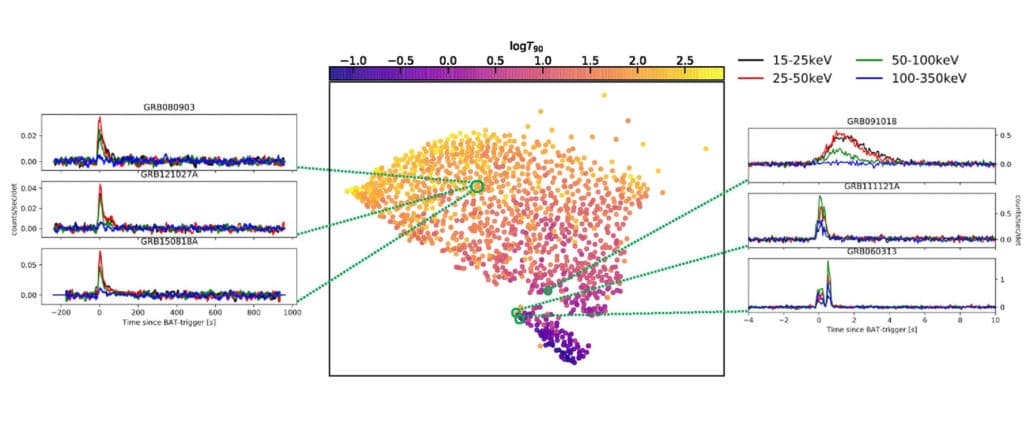Scientists at the Niels Bohr Institute, University of Copenhagen, have come up with a new approach that uses a machine-learning algorithm to classify all gamma-ray bursts (GRBs), rapid highly energetic explosions in distant galaxies, without needing to find an afterglow.
Astronomers believe that GRBs can be classified into two groups: Shorter GRBs that have a burst duration of less than 1 second and longer GRBs that have a burst duration of up to a few minutes. Both groups are overlapping. Along with this, scientists used to believe that longer bursts are produced after the collapse of massive stars, while the merger of neutron stars might instead cause shorter bursts.
However, without the ability to separate the two groups and pinpoint their properties, it has been impossible to test these ideas.
Up until now, it has just been conceivable to determine the kind of a GRB about 1% of the time, when a telescope had the option to point at the burst location rapidly enough to get residual light, called an afterglow. This has been such an essential step, that cosmologists have created overall systems fit for hindering other work and repointing enormous telescopes close to the disclosure of a new burst.
Thanks to a newly developed method, now astronomers can easily distinguish all GRBs without needing to find an afterglow. Using their method, scientists identified a clean separation between long and short GRBs. Their work, carried out under the supervision of Charles Steinhardt, will bring astronomers a step closer to understanding GRB’s.
Charles Steinhardt, Associate Professor at the Cosmic Dawn Center of the Niels Bohr Institute, explains, “This breakthrough may prove the key to finally discovering the origins of these mysterious bursts. Now that we have two complete sets available, we can start exploring the differences between them. So far, there had not been a tool to do that.”
The group, led by a first-year B.Sc. Physics students Johann Bock Severin, Christian Kragh Jespersen, and Jonas Vinther, applied a machine-learning algorithm to classify GRBs.

Students encoded all available information on GRB’s using the machine learning algorithm t-SNE. The t-distributed Stochastic neighborhood embedding algorithm takes complex, high-dimensional data and produces a simplified and visually accessible map. It does so without interfering with the structure of the dataset.
Christian Kragh Jespersen said, “The unique thing about this approach is that t-SNE doesn’t force there to be two groups. You let the data speak for itself and tell you how it should be classified.”
Johann Bock Severin said, “The preparation of the feature space – the input you give the algorithm – was the most challenging part of the project. Essentially, the students had to prepare the dataset in such a way that its most important features would stand out.”
Christian Kragh Jespersen said, “I like to compare it to hanging your data points from the ceiling in a dark room. Our main problem was to figure out from what direction we should shine a light on the data to make the separations visible.”
Charles Steinhardt said, “By the time we got to the end of the course, it was clear we had quite a significant result. This essentially is step 0 in understanding GRB’s. For the first time, we can confirm that shorter and longer GRB’s are indeed completely separate things.”
Journal Reference:
- Christian K. Jespersen et al. An Unambiguous Separation of Gamma-Ray Bursts into Two Classes from Prompt Emission Alone, 15 June 2020, Astrophysical Journal Letters. DOI: 10.3847/2041-8213/ab964d
